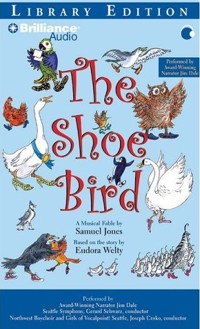



EUDORA'S FABLE: THE SHOE BIRD
A musical telling of Eudora Welty’s fanciful story
Instrumentation: *2,*2,*3,*2/2,3,1,0/T,2P,Hp/Children’s Chorus/Narrator/Stgs
Doubling Insts.: Picc., Alto Fl., Eng. Hn., Eflat Cl., Bass Cl., Alto Saxophone, Contrabassoon
Duration: 48 mins.
Commissioned by the Mississippi Boychoir, Margaret Thomas, Conductor, and introduced in 2002 in a whirlwind tour of eleven performances throughout the state of Mississippi and in Seattle, this delightful new work is winning enthusiastic audiences and captivating all who hear it.
Eudora Welty (1909-2001) is acclaimed as one of America’s greatest writers. With The Shoe Bird, her only book for children, she joins Æsop as a master of the fable, a fanciful story about animals, containing a Moral or lesson. Eudora’s fable, however, is a more complex tale than Æsop’s miniatures, and it contains multiple Morals, as every child (of whatever age) who hears this story will readily understand. Set to music by her fellow Mississippian, Samuel Jones, this delightful story comes to life as told by a Narrator and a Children’s Choir, all undergirded by the colors and drama of the Symphony Orchestra. While describing the many birds of the story, the music introduces children to the auxiliary instruments of the woodwind section, thus expanding their knowledge of the instruments of the orchestra.
The Children’s Choir“Samuel Jones’ beautifully orchestrated and carefully crafted Eudora’s Fable: The Shoe Bird is one of the most exciting and imaginative works for narrator, chorus and orchestra to appear in recent years. While designed to introduce children to the instruments of the orchestra, the text, lyrics and music, all by Mr. Jones, are sly and clever enough to appeal to adults as well. Mr. Jones has done a marvelous job of adapting Eudora Welty’s fable for musical depiction. This welcome addition to the literature should enjoy a long and successful performance life and delight audiences of children for years to come.”
--Donald Grantham,
professor of composition and head of the Division of Theory, Composition, and Jazz, School of Music, University of Texas at Austin in his adjudicatory statement for the awarding of the Music Prize, Mississippi Institute of Arts and Letters to Samuel Jones for Eudora’s Fable, June, 2003
“We presented five successful performances of a new work written by Seattle Symphony composer in residence, Samuel Jones, titled Eudora’s Fable: The Shoe Bird. Our arts in education audiences (10,000 students and teachers of the fifth grade) and Discover Music! audiences offered rave reviews -- from children and adults. There is also an outstanding teacher's guide available.”
---Patricia Kim,
Director of Education and Community Programs, Seattle Symphony in a letter to all major orchestra education directors
“Welty’s The Shoe Bird, a cautionary tale about shortchanging your native gifts for whatever’s in fashion, is shot through with the qualities that make Welty’s writing unique—glinting with poetry, showing her playful hand at word associations, conveying multiple layers of meanings and a sense of what’s important and what’s not. Jones has taken the 23,000- word children’s book with multiple characters (mostly birds) and turned it into music, retaining the essence of Welty’s singular message and style. [At one point in the story] there’s a definite element of threat, and Jones’ score conveys that with an unsettling ”Peter and the Wolf” quality. Interwoven with the score are the voices of the birds, with different instruments for different birds’ voices.
---Mary Ann Gwinn, The Seattle Times
Most works for children’s choir and orchestra use the children’s voices in a descant role, often bringing the children in at the end of the piece to build toward the finale. There has long been a need for a full length work which features the children’s choir on its own, but which is written with their technical capabilities fully in mind and which is carefully scored so that the orchestral balances avoid overpowering the young voices. Here, at last, is such a work. The children function as something of a Greek chorus, often commenting on the story, and often participating in it. When this work plays to children’s audiences, there is something mesmerizing about the sound of the children’s choir as it seems to speak directly to each child in the audience.
The Narrator
The Narrator plays a crucial role in the success of this work. It calls for a seasoned actor or actress and for someone who possesses outstanding technical skills in dramatic narration and impeccable control of dialects and characterization. There are no less than twelve different characters in the story who have spoken dialogue, each of whom needs to have his or her own “voice.” The Narrator should also be able to read music, as there are numerous places in the piece which depend upon that ability for proper ensemble.
The Orchestra
Samuel Jones has long been known as a master of orchestration, and this new work adds lustre to that reputation. Jones wanted the work to spotlight the instruments that Prokofiev did not include in his masterful Peter and the Wolf, namely, the auxiliary woodwind instruments (Piccolo, Alto Flute, English Horn, E-flat Clarinet, Bass Clarinet, Alto Saxophone, and Contrabassoon). And in place of Prokofiev’s three French Horns (to characterize the Wolf), Jones uses three Trumpets (to portray the Phoenix). Like its predecessor, however, this work uses all the sections of the orchestra to outstanding advantage. Beautiful passages for the string section abound, as well as imaginative writing for percussion and brass as well as the woodwind section.
Teachers’ Guide
An excellent Teachers’ Guide is available for the support of classroom teachers as they prepare children to attend performances of this work. Written by Suzanne Bean, Barbara Hunt, and Roben Green-Burns of the Mississippi University for Women, the guide presents suggested introductory activities as well as lesson plans for four different Unit Topics based on Eudora’s Fable, exploring patterns in Communication, Character Traits, Ornithology, and Music. The Guide also includes a copy of the text of the narration, a Vocabulary List, a List of Websites, and Teacher and Class Evaluation Forms, as well as information about the premiere performances and those who made it happen.
The Teachers’ Guide can be obtained from the Mississippi Boychoir at 153 Timberton Drive, Hattiesburg, MS 39401-8209 (Tel. 601-554-3222).
PROGRAM NOTES
Eudora's Fable
Eudora’s Fable was commissioned by the Mississippi Boychoir to celebrate the choir’s founding in 1995. The work, some two years in the making, received its World Premiere performances during an extraordinary tour throughout the state of Mississippi, followed by a set of five performances in Seattle. In large measure this new work owes its existence to the multi-talented conductor of the Mississippi Boychoir, Margaret Thomas, without whose indefatigable efforts the funding and planning for the commissioning project would never have been completed.
As most everyone knows by now, Eudora Welty (1909-2001) is acclaimed as one of America’s greatest writers. With
The Shoe Bird, her only book for children, she joins Æsop as a master of the fable, a fanciful story about animals, containing a Moral or lesson. Eudora’s fable, however, is a more complex tale than Æsop’s miniatures, and it contains multiple Morals, as every child (of whatever age) who hears this story will readily understand. This is a story about birds, all the birds of the earth, and how they follow the misguided leadership of Arturo the Parrot and his friend Gloria the Goose into wearing SHOES! This gets them into big trouble, as the Narrator will tell, and how they are rescued makes for exciting listening. The orchestra and the children’s choir take turns in commenting on the action, as Eudora’s novella for children comes to life in the concert hall.
While describing the many birds of the story, the music introduces children to the auxiliary instruments of the woodwind section. Arturo the Parrot is represented by the English Horn; Gloria the Goose, by the Alto Saxophone; and Minerva the Owl, by the Alto Flute. There are numerous other birds in the story, many of whom are portrayed by a specific woodwind instrument. It will be great fun to listen for the themes and colors the composer has chosen to describe each avian character.
- Program Notes by Samuel Jones